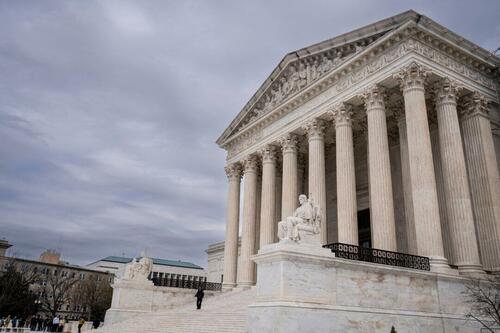The Roberts Court May Force You To Drive An EV
Authored by Thomas McArdle via The Epoch Times,
The Biden administration has just required that the majority of automotive vehicles manufactured be electric by 2032, inflicting upon the American people troublesome cars whose price is an exorbitant $53,500 on average and that cost a fortune to repair. House Speaker Mike Johnson warned that the move will “devastate auto manufacturers.”
While electric vehicles (EVs) totaled less than 8 percent of sales of new cars last year, the Biden rule demands they reach as much as 56 percent in less than a decade, and as much as 36 percent for plug-in hybrid vehicles. The regulatory method to be employed is mandating that automakers cut carbon dioxide emissions by more than half by eight years from now. Far sooner than that as a result, just several years down the road, Americans may no longer be able to afford an ordinary gasoline-powered vehicle.
The extremism of the new regulations is a direct result of something many Americans likely didn’t think had anything to do with revolutionizing and dictating the ways they get themselves from point A to point B—2022’s so-called Inflation Reduction Act (IRA).
While doing nothing to reduce inflation, the law acted as step one of the implementation of President Joe Biden’s Green New Deal, giving the Environmental Protection Agency (EPA) explicit powers regarding greenhouse gases and in forcing solar, wind, and other expensive alternatives to fossil fuels on the private sector. The IRA’s Title VI amended the Clean Air Act to identify by name pollutants, including CO2, so the EPA would have congressional authorization to regulate them and shift to pricier green forms of energy.
Overlaid on the new powers were massive amounts of new taxpayer cash, with the act spending approximately $370 billion in incentives for solar panels, EVs, and other environmentalist wares that can’t make it in the market. Demand for electric transportation, meanwhile, looks unpromising, with Ford reducing EV manufacturing to the tune of the withdrawal of $12 billion, and Toyota looking more to hybrids than EVs.
The Biden regs set the stage for a battle royale in the Supreme Court, but to know why, let’s back up.
Congress had in 2010 settled the issue of whether carbon emissions from coal plants could be capped, deciding in favor of coal and thus saving an industry that directly provides livelihoods for tens of thousands of Americans. President Barack Obama responded by issuing EPA regulations that imposed such a cap, his administration’s Clean Power Plan of 2015. This ended the constraint against the EPA’s imposing emission reduction methods that would put coal plants out of business.
In effect, President Obama took it upon himself to rewrite the 1970 Clean Air Act via the use of an obscure, vague provision within it and force coal plants that reached the carbon emissions cap to stop operations, finance new plants classified as clean, or buy their way out via emissions allowances—anesthetizingly referred to as “cap and trade.” His autocratic scheme had the obvious goal of shutting down the nation’s coal industry in stark defiance of Congress’s wishes, using established statutory language to exercise new powers not authorized or intended by those old laws.
Not surprisingly, coal industry states such as West Virginia sued the EPA. And in 2022 in a 6–3 decision, the Supreme Court issued a landmark ruling in favor of the Mountain State, and 19 others, against the environmental agency and its “expert” bureaucrats in exercising these powers not granted by lawmakers.
Quoting Justice Brett Kavanaugh’s statement in a 2017 case, Chief Justice John Roberts pointed out in the majority opinion that the justices “presume that ‘Congress intends to make major policy decisions itself, not leave those decisions to agencies.’”
“Thus, in certain extraordinary cases, both separation of powers principles and a practical understanding of legislative intent make us ‘reluctant to read into ambiguous statutory text’ the delegation claimed to be lurking there,” he wrote.
An agency such as the EPA “must point to ‘clear congressional authorization’ for the power it claims.”
The misnamed Inflation Reduction Act was written by Democrats to function as that clear legislative license the chief justice demanded; one Harvard law professor predicted it would strongly discourage future lawsuits against the EPA. But the new powers the IRA gives the EPA still do not go as far as President Obama’s Clean Power Plan, which imposed exacting carbon emission reductions upon individual states based on their various energy consumption levels, each state being required to submit a plan or have the EPA force its own plan on them.
Despite the Harvard professor’s soothsaying, litigation against the agency is sure to materialize. Will the West Virginia v. EPA majority hold and view President Biden’s new plan to wreck the American automotive industry as another executive branch power grab that extends beyond Congress’s intentions? Will Chief Justice Roberts be flattered that federal legislators provided the “clear congressional authorization” he suggested, if indeed he determines that is what it is? Or might others among the six SCOTUS conservatives making up the West Virginia majority peel away?
If Congress really does want to de-industrialize the United States of America in the name of global warming, it seems reasonable to insist that it does so in language that cannot be interpreted otherwise. Whether the Supreme Court chooses to demand that standard will determine whether auto transport is soon taken out of financial reach for millions of Americans.
Tyler Durden
Wed, 03/27/2024 – 13:25
via ZeroHedge News https://ift.tt/CG7IHKu Tyler Durden
